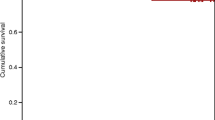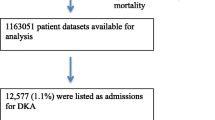Abstract
Aims
The rate of inpatient mortality associated with diabetic ketoacidosis (DKA) has steadily decreased in recent decades. However, there remains a significantly increased outpatient death rate following an episode of survived DKA. We undertook this study to investigate the observed increase in mortality following an episode of DKA.
Methods
We completed a retrospective cohort study to investigate rates and causes of death in people admitted to our hospital with DKA between 2013 and 2018. DKA was confirmed by pre-defined biochemical parameters and cause of death data was extracted from multiple sources. Follow-up was for two years after discharge for all participants with one-year mortality being the main time point for analysis.
Results
We identified 818 admissions to hospital with DKA, affecting 284 people. Twenty people died as inpatients and a further 40 people died during the two-year follow-up. Of these 60 participants, cause of death was able to be determined for 41 (68%), with most deaths occurring due to infection or macrovascular disease. Risk factors for death within a year of hospital discharge included older age, vascular complications of diabetes, intellectual impairment and residential care living. Those who survived an episode of DKA had a one-year age-corrected mortality rate 13 times higher than the general population. This was more marked in the younger cohort with those aged 15–39 years being 49 times more likely to die in the year after surviving a DKA admission compared to their general population counterparts.
Conclusion
An episode of diabetic ketoacidosis is associated with a significant outpatient mortality risk with most deaths due to infectious or macrovascular causes. This study should prompt investigation of predictive scoring tools to identify those at increased mortality risk after DKA and encourage the development of targeted interventions to reduce mortality.

Similar content being viewed by others
Data availability
This study reports confidential health data on patients that cannot be made available in a public repository, even if anonymised, as per conditions of the ethics approval. Nonetheless, the anonymised data on which this manuscript was based could be made available to other investigators upon bona fide request, and following all the necessary approvals (including ethics approval) of the detailed study proposal and statistical analyses plan. Any queries should be directed to the corresponding author.
References
Cooper H, Tekiteki A, Khanolkar M, Braatvedt G (2016) Risk factors for recurrent admissions with diabetic ketoacidosis: a case-control observational study. Diabet Med 33(4):523–528
Bagg W, Sathu A, Streat S, Braatvedt GD (1998) Diabetic ketoacidosis in adults at Auckland Hospital, 1988–1996. Aust N Z J Med 28(5):604–608
Skrivarhaug T, Bangstad HJ, Stene LC, Sandvik L, Hanssen KF, Joner G (2006) Long-term mortality in a nationwide cohort of childhood-onset type 1 diabetic patients in Norway. Diabetologia 49(2):298–305
Secrest AM, Becker DJ, Kelsey SF, LaPorte RE, Orchard TJ (2010) All-cause mortality trends in a large population-based cohort with long-standing childhood-onset type 1 diabetes. Diabetes Care 33(12):2573–2579
Ramaesh A (2016) Incidence and long-term outcomes of adult patients with diabetic ketoacidosis admitted to intensive care: a retrospective cohort study. J Intensive Care Soc 17(3):222–233
Huang CC, Weng SF, Tsai KT, Chen PJ, Lin HJ, Wang JJ et al (2015) Long-term mortality risk after hyperglycemic crisis episodes in geriatric patients with diabetes: a national population-based cohort study. Diabetes Care 38(5):746–751
Kao Y, Hsu CC, Weng SF, Lin HJ, Wang JJ, Su SB et al (2016) Subsequent mortality after hyperglycemic crisis episode in the non-elderly: a national population-based cohort study. Endocrine 51(1):72–82
Stats NZ (2021) Subnational population estimates (DHB, DHB constituency), by age and sex, at 30 June 1996–2021 (2021 boundaries) [Internet]. Available from http://nzdotstat.stats.govt.nz/wbos/Index.aspx?DataSetCode=TABLECODE7509. Accessed 13 Jan 2022
Secrest AM, Becker DJ, Kelsey SF, LaPorte RE, Orchard TJ (2010) Cause-specific mortality trends in a large population-based cohort with long-standing childhood-onset type 1 diabetes. Diabetes 59(12):3216–3222
Stats NZ (2022) Infoshare Population death rates [Internet]. Available from: https://infoshare.stats.govt.nz/. Accessed 5 Feb 2022
Coggon D, Rose G, Barker DJP (2003) Chapter 3 Comparing disease rates. In: Epidemiology for the unititiated [Internet], 5th edn. London: BMJ books. Available from https://www.bmj.com/about-bmj/resources-readers/publications/epidemiology-uninitiated/3-comparing-disease-rates. Accessed 28 Apr 2022]
Newcombe RG (1998) Two-sided confidence intervals for the single proportion: comparison of seven methods. Stat Med 17(8):857–872
Armitage P, Berry G (1994) Statistical methods in medical research [Internet], 3rd edn. England: Blackwell Scientific Publications. Available from https://www.ncbi.nlm.nih.gov/nlmcatalog/9309522. Accessed 28 Apr 2022
Rothman KJ (1990) No adjustments are needed for multiple comparisons. Epidemiol Camb Mass 1(1):43–46
Ministry of Health (2022) Population of Auckland DHB [Internet]. Ministry of Health NZ. Available from https://www.health.govt.nz/new-zealand-health-system/my-dhb/auckland-dhb/population-auckland-dhb. Accessed 25 Apr 2022
Heald A, Stedman M, Robinson A, Davies M, Livingston M, Alshames R et al (2022) Mortality rate associated with diabetes: outcomes from a general practice level analysis in England using the royal college of general practitioners (RCGP) database indicate stability over a 15 year period. Diabetes Ther 13(3):505–516
Thunander M, Lindgren A, Petersson C, Landin-Olsson M, Holmberg S (2020) Standard mortality rates and years of life lost for serologically defined adult-onset type 1 and type 2 diabetes—a fifteen year follow-up. Diabetes Res Clin Pract 1(160):107943
Yang JJ, Yu D, Wen W, Saito E, Rahman S, Shu XO et al (2019) Association of diabetes with all-cause and cause-specific mortality in Asia: a pooled analysis of more than 1 million participants. JAMA Netw Open 2(4):e192696
Gibb FW, Teoh WL, Graham J, Lockman KA (2016) Risk of death following admission to a UK hospital with diabetic ketoacidosis. Diabetologia 59(10):2082–2087
Elsheikh A, Abdullah A, Wahab A, Eigbire GE, Salama A, Rajamani K (2018) Impact of obesity on outcomes of diabetic ketoacidosis—results from the national inpatient sample. Diabetes 67:2085
Hamman RF (2010) Mortality risk in long-standing type 1 diabetes: hope and concern. Diabetes 59(12):2997–2998
Acknowledgements
The authors acknowledge the receipt of the Fiona Wu Research Grant awarded by the Auckland Diabetes Centre. We also acknowledge the work of Dr José Derraik and Dr Jo Secher who provided assistance with statistical analysis.
Funding
Auckland Diabetes Centre.
Author information
Authors and Affiliations
Contributions
All authors contributed to the study conception and design; JS and PM: data collection was performed; GB: provided supervision; JS: the first draft of the manuscript was written and all authors commented on previous versions of the manuscript. All authors read and approved the final manuscript.
Corresponding author
Ethics declarations
Conflict of interest
The authors were awarded the Fiona Wu Research Grant awarded by the Auckland Diabetes Centre.
Ethical approval
This retrospective chart review study involving human participants was conducted in accordance with the ethical standards of our institutional research committee and with the 1964 Helsinki Declaration and its later amendments or comparable ethical standards.
Informed consent
The requirement for individual informed consent was waived due to the nature of this study.
Additional information
Managed by Massimo Porta.
Publisher's Note
Springer Nature remains neutral with regard to jurisdictional claims in published maps and institutional affiliations.
Rights and permissions
Springer Nature or its licensor holds exclusive rights to this article under a publishing agreement with the author(s) or other rightsholder(s); author self-archiving of the accepted manuscript version of this article is solely governed by the terms of such publishing agreement and applicable law.
About this article
Cite this article
Shand, J.A.D., Morrow, P. & Braatvedt, G. Mortality after discharge from hospital following an episode of diabetic ketoacidosis. Acta Diabetol 59, 1485–1492 (2022). https://doi.org/10.1007/s00592-022-01953-5
Received:
Accepted:
Published:
Issue Date:
DOI: https://doi.org/10.1007/s00592-022-01953-5




